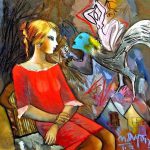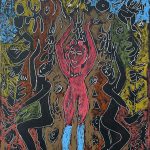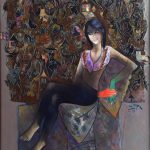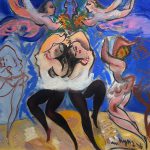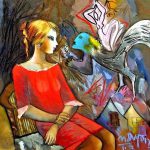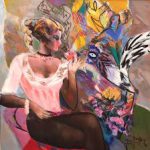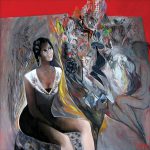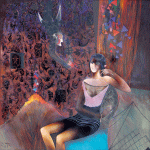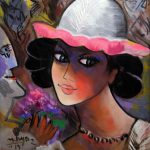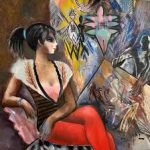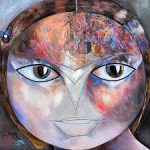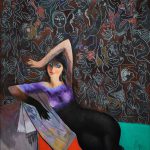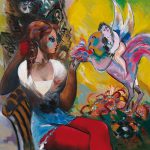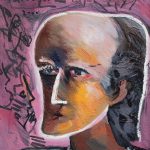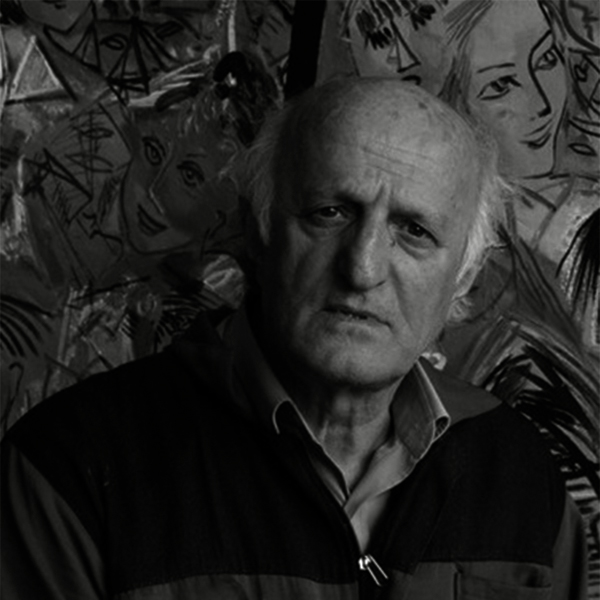
Who is Mustafa Ayaz?
Mustafa Ayaz was born in 1938 in the Kabataş Village of Trabzon’s Çaykara district as the fourth child of the family. World War II, the largest and most destructive war in history. Ayaz, who spent his childhood years in poverty and illness during the depressed times of World War II, had the chance to be the only child his family could educate. Erzurum-Pulur Village Institute, where Ayaz started primary school at the age of 10 and graduated in 1953, took the boarding exam to continue his school life and passed, and was the place where his interest in painting began.
Gençaydın stated that the important coincidence that brought Ayaz into art was the “Osman Kaptan” reading passage, whose physical portrait was described in the eighth grade Turkish book and in which the picture of the story heroes was asked to be drawn in the homework section, and that Ayaz took the exam at the Istanbul-Çapa Primary Teacher School Art Seminar with the recommendation of his teacher, who liked the portrait he drew very much. He states that he has entered and thus the path to Mustafa AYAZ on which he will proceed has been determined.
The artist, who passed the entrance exam and had the opportunity to receive art education from important names such as İlhami Demirci and Malik Aksel, graduated from Çapa Primary Teacher Training School in 1959. After teaching primary school for a year, he entered the Painting Department of Gazi Education Institute, which has an important place in art life, in 1960 and graduated in 1963.
Ayaz, who worked as an art teacher and workshop manager at Çorum Primary School between 1963-66, passed the assistant exam of Gazi Education Institute Painting Department in 1966 and worked as an art teacher at the same school until 1984. The artist, who transferred to Hacettepe University Faculty of Fine Arts in 1984 and retired 3 years later in 1987, received the title of Professor in the same year. Ayaz left Bilkent University, Faculty of Fine Arts, where he last worked, at his own request in 1988.
Ayaz said that painting is not his profession but his breath, "I breathe with it, I live with it," and added: "An artist should paint every day as if he were breathing." "Just as we cannot live without breathing, a real artist becomes restless without painting," he says, and states that it is not possible to become a permanent painter by painting once a week or a few times a month, pouring two buckets of paint and drawing a few lines. Ayaz, who has between 10 and 15 thousand drawings, said: "If I spend even one day without getting my hands on the pen, line or paint, I will feel uncomfortable, uneasy, and say there is something missing in me." His words show his endless love for art and diligence.
Gençaydın also states that Ayaz, whom he describes as a Black Sea child who is fidgety and unable to sit still, like the folk dances of his region, is known around him as a person who constantly chooses painting as a way of life and finds the pleasure of life in working.
Ayaz, for whom the great meaning of life is painting, says that people should pursue what they love because in the end they reach a very beautiful place, and describes the pleasure felt from this as "arriving in the heaven of the world". expresses as. Undoubtedly, the paradise that Mustafa Ayaz reached on earth is the 7-storey museum bearing his name, the construction of which started in Ankara in 2003 on an area of 1720 m² and was completed in 2007. Ayaz states that he built the "Mustafa Ayaz Foundation Plastic Arts Museum", which was established as a foundation in 2009 and includes galleries, painting workshops, a library, a souvenir section and a cafe, first for himself and then for Atatürk and his debt to him and for art lovers.
Talking about his thoughts about the museum, the artist said, "Imagine, there is a person who works hard, makes a lot of effort, is very knowledgeable, very skillful, but if he leaves this world without sharing his knowledge and experiences with society and humanity, it is worthless, his deeds go to the grave with him. It is important." "What happens is sharing the labor." He emphasizes the importance of the need for people to work hard and share what they have learned and what they have done, and says, "For example, I worked hard, put in a lot of effort, and as a result of that work, I crowned it by building this museum." In his words, he states that he fulfills his duty of sharing his labor with the society by bringing together the works he created as a result of intense labor and dedication throughout his life with art lovers in his museum, which he defines as the place where his dreams come true.
Women of Ayaz
The distinguishing feature in the works of Mustafa Ayaz, who has written his name in Turkish art history as one of the important painters of Contemporary Turkish painting, at the end of the solid path he has paved with his determination and diligence since the first moment he met art, is the female figures he puts in the center of attention. The women painted by Ayaz, who finds the female image more suitable for aesthetic and pictorial form, appear as an analysis and synthesis of his artistic view of women in nature.
For the artist who paints Ayaz women by working on the female image with his own unique interpretation, the way it is handled and interpreted in an original way is more important than the optical image of the woman.
In his works, where the artist's linear expression style dominates, the colors he uses to depict women are also quite striking. Saying that it is not possible to paint with a prejudice about color, Ayaz said that the colors he used in female figures do not have a specific language or a special meaning. Stating that he can start with red and finish with blue, the artist colors the female figures he works with according to color harmony.
The black sock motif, which he defines as a symbol of the love and closeness he feels towards the opposite sex, is the reflection of the village women on his canvas, which is in the subconscious of the artist's childhood. Red socks is a motif that he started with the painting of a female student wearing red socks standing as a model at Gazi University, and then continued to work on female figures. Based on this, it is concluded that the artist's memories deep in his subconscious play a very important role in the works of art he produces. In addition, it is seen that the coloring view that dominates all his works is also valid for sock motifs. What is important for Ayaz is artistic activity rather than the colors of the sock motifs that sometimes cover women's entire bodies.
It is possible to see that Ayaz, who thought that the artist should paint almost every day without stopping, placed himself next to the female figures as a guard. This approach stems from the strong bond the artist has established between himself and his paintings, as well as his desire to show that he is present in almost every detail of the work.
It is possible to see in the paintings of Mustafa Ayaz, who crowned his art journey with the museum bearing his name and who said, "There is a constant lovemaking, a war between the artist and the canvas, eventually the two come to a mutual peace, and that's when the painting is signed," that the war he had with his women ended with absolute peace.
Awards
2009 Ankara Rotary Club, Professional Service Award
2009 Art Foundation, Special Jury Prize
2008 Hacettepe University, 2008–2009 Academic Year, Service to Art Award
2008 Art Institution, Artists of the Year Award in Painting
2007 ArtForum Art Fair, Mustafa Ayaz Museum - Institutional Honor Award
2007 Çağsav Honor Award
2005 EgeArt Art Fair Award
1999 Hacattepe University 1998-1999 Academic Year Art Award
1988 Mimar Sinan 400th Anniversary Commemoration 2nd Prize
1986 T. Petrolleri A.Ş. Success Award in Painting Competition
Success Award in 1983 Meteksan Pattern Competition
1983 44th State Painting and Sculpture Exhibition Achievement Award
Honorable Mention in the 1982 DYO Painting Competition
1980 41st State Painting and Sculpture Exhibition Achievement Award
Achievement Award at 1977 DYO Painting Competition
Achievement Award at 1975 DYO Painting Competition
1973 Success Award in the 50th Anniversary of the Republic Painting Competition
1972 34th State Painting and Sculpture Exhibition Achievement Award
1971 33rd State Painting and Sculpture Exhibition, 2nd Prize
1971 TRT Art Award
2nd Honorable Mention in the 1969 Youth Painting Competition
